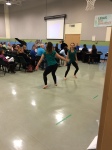
Three years ago, Cathy Rowland, the piano teacher at the high school where I teach, asked me and the art teacher, Jason Sturgill, if we would like to collaborate with her during a piano recital. Her idea was that her students could learn piano pieces around a theme, and our students, creative writers and visual artists, could be inspired by those arrangements. Her vision was that all the creation could happen at the same time, in the same room, while the pianos played. Writers writing and reading their work, artists painting, dancers dancing, actors acting in a dynamic, unrehearsed, live integration.
We did it. And have continued to do it for the last three years. For teachers who are trying to build an arts integration program within their school, here’s the story of our collaboration.
Six weeks before the showcase, my creative writing students met with Rowland’s piano students to listen to the music. Each student chose one or two songs with which they felt an immediate attraction.
In addition to listening to the musical compositions over and over, the poets researched the history of the songs, the life stories of the composers, and different forms, such as Russian folk ballads, Germanic legends of the supernatural and Chinese poetic traditions. During the six weeks, their poems started to emerge.
“I typically write just for myself, but this experience forced me to write for an experience that was being communicated through music by the composers and the pianists. I started to look at music as language, emotion, and thought,” said creative writer Hannah Bernard. “I felt like my poems were much more dynamic and complex because of the music.”
As each piano student performed, they were accompanied by either a piece of drama, art, poetry or drama. Each student artist created a piece of art in his or her discipline, based on the music of Debussy, Tchaikovsky, and Beethoven, to name a few of the featured composers.
“Playing the piano is traditionally a solitary experience,” said Rowland. “Through this collaboration with students in other arts areas, the piano students were given the opportunity to share their interpretations of both their solo and ensemble pieces with the other artists.”
“My students listen to the piano arrangements to get a feel for what they saw in the music,” said art teacher Jason Sturgill. “I feel like I learned, and my students learned too, a valuable lesson about community.” Some art students completed their works before the showcase and displayed them, but other students painted their works as the pianists performed.
“It was like art theatre. The audience was behind me, and I zoned out and pretended they weren’t there. The music was all around me as I created,” said graphic artist Nia Burney, who created a digital piece with ArtRage studio software.
In addition to become an invaluable learning tool for students, the showcase also provided an exhibition of the wide range of arts disciplines within our school. Parents, faculty, administration and community members were on hand to witness the range of student talent. “I can think of no better way to demonstrate the value of our arts program than to experience all of the arts on display in the same program,” said drama teacher Paul Thomas.
If your school wants to host an all-arts spotlight, determining a theme is crucial to create cohesiveness among the artistic products and performances. After determining a theme that provides artistic unity, students interpret the theme through their own original, interpretative directions. Elementary classrooms could create a showcase within a single classroom, while high school arts components could collaborate across arts disciplines or even content areas.
This project proved what is best about the collaborative dynamic –creation and self-reflection that moves outside the individual artist into a community.










